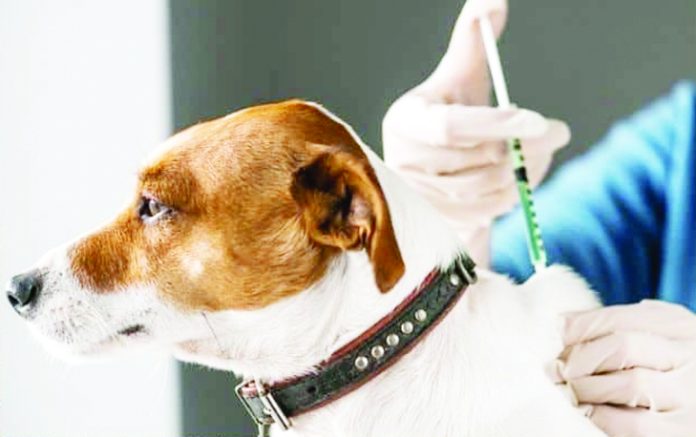Dr. Sitikantha Banerjee, Dr. Sanjolly Gupta
Rabies is a deadly viral disease, affecting nervous system of both men and mammals. Globally it is endemic in more than 150 countries. Though Rabies has been eliminated from North America, Western Europe, South Korea, Japan and a part of Latin America, it is still an important public health problem largely in Africa and Asia. India is a rabies endemic country, and each year an estimated 20,000 people die due to Rabies infection in India.
Route of Transmission in men and animals
Usually, the disease is transmitted by bites, scratches, or direct contact with mucosa by a rabies infected animal. Dogs are most important source of human rabies in India, contributing up to 97% of all rabies transmissions. Pets most frequently get infection from another animal (stray dogs/wild animals). People cannot get rabies just by touching or being near an animal with rabies.
Strategies for Rabies Control
Rabies is almost 100% fatal both for human and animals. So, the strategies to eliminate rabies are directed towards preventing people from developing this deadly disease. According to World Health Organization (WHO) rabies can be prevented through complete Immunization of people exposed to rabies virus, eliminating rabies in dogs by vaccination of dogs, prevention of dog bites and awareness generation. An integrated one-health approach is globally approved for rabies control, where medical scientists and veterinary public health consultants need to deliver a collaborative effort.
Need for dog Vaccination
Rabies vaccines for dogs can not only eliminate the disease from them, it also prevents spread of infection to human. According to World Organisation for Animal Health (WOAH), Mass dog vaccination campaigns is an effective pillar to tackle the disease, and human transmission can be stopped by vaccinating at least 70% of dogs in at-risk areas.
Vaccination schedule for pets
Rabies vaccine is considered as one of the essential core vaccines for canine animals. In mass vaccination programs, inactivated rabies vaccines are mostly used. Vaccination for dogs and cats can be initiated at the minimum age of three and two months of age respectively. Irrespective of the age of initial vaccination, a booster vaccine need to be administered one year after the initial dose. Subsequently, booster dose need to be administered every year/ three years, based on the type of vaccine, as determined by the manufacturer and indicated on the product label. An animal is considered as immunized 28 days after initial vaccination, as that time the peak antibody titer is reached. They should be considered as unvaccinated when the vaccine’s official duration of immunity is over (one year or three years). Only a qualified veterinarian can administer rabies vaccine. Minor adverse events following immunization in pets include transient injection-site reactions or hair loss. Oral recombinant rabies vaccines have increasingly gained popularity for mass dog vaccination in countries with high volume of stray dogs. Those vaccines are blister packed and can be enclosed in specific food prepared for them.
Responsibility of pet owners
Based on the recommendations of the Centers for Disease Control and Prevention (CDC), USA, Global Alliances for Rabies Control and considering India scenario, following advices could be helpful for pet owners to prevent pet-mediated rabies. Firstly, owners need to regularly visit the veterinarian with the pet and keep rabies and other core vaccinations up-to-date for all pets. Dogs should be kept under direct supervision, especially when it is playing outside, as there is always a chance to acquiring rabies in the pet from a stray dog/cat who may be a case/carrier of rabies. Special protection needs to be taken while travelling with the pet. Owners should spay or neuter pets, which is necessary to decrease the number of unwanted pets, that may not be properly cared for or regularly vaccinated. If anyone notices any animal (pet/stray) with unusual behaviour, or any wild animal, she/he needs to urgently inform the local municipality/ animal control office to remove it from the locality, since those animals could be a potential case of Rabies. Further, provision of healthy nutritious food, clean water, clean and comfortable shelter are also required for pets. Pets need to be kept on a leash when going out, however they should not be tied up all the times. Other responsible practices include not bothering dogs when they are eating or sleeping, avoid putting kids face right up to the dogs face, avoid grabbing its tail/ear, avoid climbing on it, avoiding shouting, screaming and other loud noises (drums, crackers etc).
Identification of an animal suffering from rabies
After the incubation period of about 3 months, dogs start developing symptoms. There may be altered behaviour, feeding habits or bark tone. The animals may stop taking food or eat abnormal objects. Following symptoms may be present: fever, vomiting, excessive salivation, restlessness, convulsions, paralysis followed by death within five to seven days of the onset of disease. Some may become very aggressive and try to bite men or other animals. They may drool more than normal (foaming at the mouth). Others may become timid or shy, move slowly, act tame, or let people get close to them. If following symptoms are noticed in dogs, possibility of Rabies should always be kept in mind: problem in swallowing, excessive drool or saliva, extremely aggressive, biting at imaginary objects (“fly biting”), appears tamer, having trouble moving or paralyzed. Cats suffering from rabies can show excessive aggressiveness, high sensitivity to touch/noise, profuse salivation and may attack dog or even man. If any animal is acting unusually, local municipality/ animal control department need to be informed urgently for help.
Conclusion
It can be emphasized that both human and canine rabies are 100% vaccine-preventable diseases. Pet owners need to regularly vaccinate their pets, not only to protect the pet from rabies, but also to prevent spread rabies to the owner and other people in the community.
Trending Now
E-Paper


